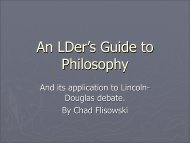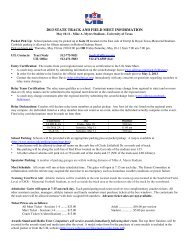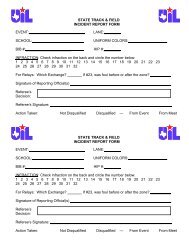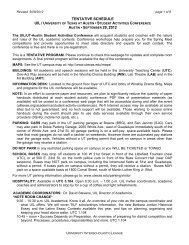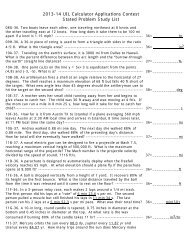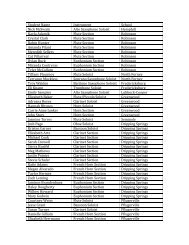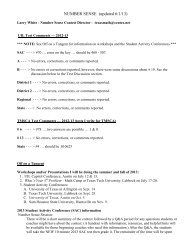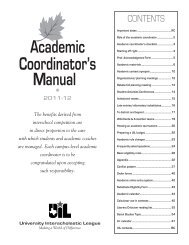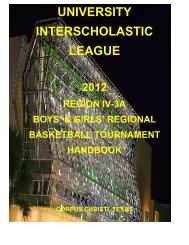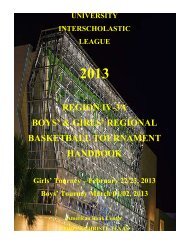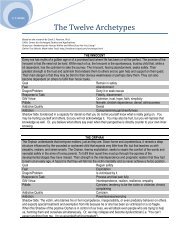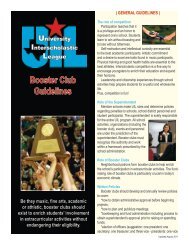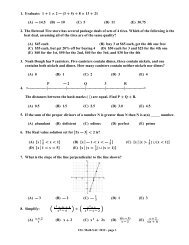English Lesson to Prepare for UIL Literary Criticism Contest Lesson ...
English Lesson to Prepare for UIL Literary Criticism Contest Lesson ...
English Lesson to Prepare for UIL Literary Criticism Contest Lesson ...
Create successful ePaper yourself
Turn your PDF publications into a flip-book with our unique Google optimized e-Paper software.
<strong>English</strong> <strong>Lesson</strong> <strong>to</strong> <strong>Prepare</strong><br />
<strong>for</strong> <strong>UIL</strong> <strong>Literary</strong> <strong>Criticism</strong> <strong>Contest</strong><br />
<strong>Lesson</strong> Plan Title: Using Close Reading Skills <strong>for</strong> Fiction<br />
Goal of <strong>Lesson</strong>: To create building blocks so that students have the ability <strong>to</strong> analyze fiction<br />
<strong>for</strong> deeper understanding and precise interpretation.<br />
Subject/Grade Level: <strong>English</strong> I – IV (esp. Pre-AP & AP)<br />
TEKS Addressed:<br />
(5) Reading/Comprehension of <strong>Literary</strong> Text/Fiction. Students understand, make inferences and draw conclusions<br />
about the structure and elements of fiction and provide evidence from text <strong>to</strong> support their understanding. Students<br />
are expected <strong>to</strong>:<br />
(A) analyze isolated scenes and their contribution <strong>to</strong> the success of the plot as a whole in a variety of works of<br />
fiction;<br />
(B) analyze differences in the characters' moral dilemmas in works of fiction across different countries or cultures;<br />
(C) evaluate the connection between <strong>for</strong>ms of narration (e.g., unreliable, omniscient) and <strong>to</strong>ne in works of fiction;<br />
and<br />
(D) demonstrate familiarity with works by authors from non-<strong>English</strong>-speaking literary traditions with emphasis on<br />
20th century world literature. (ELAR 1-2)<br />
(5)(A) analyze how complex plot structures (e.g., subplots) and devices (e.g., <strong>for</strong>eshadowing, flashbacks, suspense)<br />
function and advance the action in a work of fiction;<br />
(B) analyze the moral dilemmas and quandaries presented in works of fiction as revealed by the underlying<br />
motivations and behaviors of the characters; (ELAR 3-4)<br />
(15)(C) write an interpretation of an exposi<strong>to</strong>ry or a literary text that:<br />
(i) advances a clear thesis statement;<br />
(ii) addresses the writing skills <strong>for</strong> an analytical essay, including references <strong>to</strong> and commentary on quotations from<br />
the text:<br />
(iii) analyzes the aesthetic effects of an author's use of stylistic or rhe<strong>to</strong>rical devices;<br />
(iv) identifies and analyzes the ambiguities, nuances, and complexities within the text; and<br />
(v) anticipates and responds <strong>to</strong> readers' questions or contradic<strong>to</strong>ry in<strong>for</strong>mation. (ELAR 1-4)<br />
Overview of <strong>Lesson</strong>:<br />
The teacher will guide a class discussion <strong>for</strong> the purpose of using close reading techniques <strong>to</strong><br />
analyze a chapter of a novel or a short s<strong>to</strong>ry. Next, students will independently analyze a<br />
second chapter or short s<strong>to</strong>ry, using the same close reading strategies.<br />
Materials Needed:<br />
1. Novel from the <strong>Literary</strong> <strong>Criticism</strong> reading list (list can be found at bot<strong>to</strong>m of<br />
www.uil.utexas.edu/academics/index.html) or any short s<strong>to</strong>ry or novel <strong>to</strong> be assigned in<br />
class<br />
2. List of Close Reading Techniques <strong>for</strong> Fiction (attached)<br />
Procedures and Activities:<br />
The teacher will –<br />
• present the values of close reading techniques, emphasizing their importance <strong>for</strong><br />
personal reading, school assignments and tests, such as SAT, ACT, AP, etc.<br />
• provide students with a copy of the close reading techniques <strong>for</strong> fiction (attached).<br />
• provide students with the novel from the literary criticism reading list or another novel or<br />
short s<strong>to</strong>ry.<br />
• ask students <strong>to</strong> underline or highlight key words, phrases or ideas as they read the first<br />
chapter of the novel (or short s<strong>to</strong>ry).
• model use of close reading techniques by guiding a class discussion which asks the<br />
students <strong>to</strong> apply the close reading techniques <strong>to</strong> the fiction.<br />
Independent Practice:<br />
The teacher will –<br />
• assign students <strong>to</strong> read independently the second chapter or another short s<strong>to</strong>ry.<br />
• have students use the close reading techniques so that they can independently analyze<br />
the second piece of fiction.<br />
• assign students <strong>to</strong> analyze the second chapter (or short s<strong>to</strong>ry) by writing a paragraph<br />
about each of the items I – VI of the close reading techniques.<br />
Assessment:<br />
Evaluation of student paragraphs on items I - IV of the close reading strategies as applied <strong>to</strong><br />
the second chapter or s<strong>to</strong>ry.
Close Reading Techniques <strong>for</strong> Fiction<br />
(suggestions from A P Teacher Resources & Dr. Chad Osborne of the Teacher Development Network)<br />
I. First Impressions:<br />
What are the first things you notice about the literature?<br />
Do the things you noticed complement each other or contradict each other and what does<br />
that imply?<br />
What does the title suggest?<br />
What mood does the passage create? Why?<br />
II. Use of Language (Vocabulary, Diction):<br />
What are the first words that you notice? Why?<br />
How do the important words relate <strong>to</strong> one another?<br />
Do any word choices/uses seem unusual <strong>to</strong> you? Why?<br />
Do any words have double meanings or extra connotations?<br />
What are the unfamiliar words? How can you determine their meanings?<br />
III. Discerning Patterns (Repetitions, Similarities, Contradictions, Images):<br />
Does an image remind you of an image elsewhere in the literature? Where? What's the<br />
connection?<br />
How might this image fit in<strong>to</strong> the pattern as a whole?<br />
Could this passage symbolize the entire work? Could this passage serve as a microcosm--a<br />
little picture--of what's taking place in the whole work?<br />
What is the sentence rhythm like? Short and choppy? Long and flowing? Does it build on<br />
itself or stay at an even pace? What is the style like?<br />
Look at the punctuation. Is there anything unusual about it?<br />
Is there any repetition within the passage? What is the effect of that repetition?<br />
How many types of writing are in the passage? (For example, narration, description,<br />
argument, dialogue, rhymed or alliterative poetry, etc.)<br />
Can you identify an inconsistency in the author's thought or subject?<br />
What is left out or kept silent? What would you expect the author <strong>to</strong> talk about that the<br />
author avoided?<br />
IV. Point of View and/or Characterization:<br />
How does the passage make us react or think about any characters or events within the<br />
narrative?<br />
Are there colors, sounds, physical description that appeals <strong>to</strong> the senses? Does this imagery<br />
<strong>for</strong>m a pattern? Why might the author have chosen that color, sound or physical description?<br />
Who speaks in the passage? To whom does he or she speak? Does the narra<strong>to</strong>r have a<br />
limited or partial point of view? Or does the narra<strong>to</strong>r appear <strong>to</strong> be omniscient, knowing things<br />
the characters couldn't possibly know?<br />
What background is revealed about the characters? What important in<strong>for</strong>mation about the<br />
characters adds insight?<br />
V. Symbolism:<br />
Are there metaphors? What kinds?<br />
Is there one controlling or extended metaphor? If not, how many different metaphors are<br />
there, and in what order do they occur? How might that be significant?<br />
How any objects represent something else? What does that imply?<br />
Do any of the objects, colors, animals, or plants appearing in the passage have traditional<br />
connotations or meaning? What about religious or biblical significance?<br />
If there are multiple symbols in the work, could we read the entire passage as having<br />
allegorical meaning beyond the literal level?<br />
VI. Theme and Thesis<br />
Based on the in<strong>for</strong>mation you have gathered from your analysis, what is the theme that is<br />
implicitly or explicitly suggested?<br />
What is the assertion or message of the literature?
<strong>English</strong> <strong>Lesson</strong> <strong>to</strong> <strong>Prepare</strong><br />
<strong>for</strong> <strong>UIL</strong> <strong>Literary</strong> <strong>Criticism</strong> <strong>Contest</strong><br />
<strong>Lesson</strong> Plan Title: Using Close Reading Skills <strong>for</strong> Poetry<br />
Goal of <strong>Lesson</strong>: To create building blocks so that students have the ability <strong>to</strong> analyze poetry<br />
<strong>for</strong> deeper understanding and precise interpretation.<br />
Subject/Grade Level: <strong>English</strong> I – IV (esp. Pre-AP & AP)<br />
TEKS Addressed:<br />
(3) Reading/Comprehension of <strong>Literary</strong> Text/Poetry. Students understand, make inferences and draw conclusions<br />
about the structure and elements of poetry and provide evidence from text <strong>to</strong> support their understanding. Students<br />
are expected <strong>to</strong> analyze the structure or prosody (e.g., meter, rhyme scheme) and graphic elements (e.g., line<br />
length, punctuation, word position) in poetry. (ELAR 1-4)<br />
(7) Reading/Comprehension of <strong>Literary</strong> Text/Sensory Language. Students understand, make inferences and draw<br />
conclusions about how an author's sensory language creates imagery in literary text and provide evidence from text<br />
<strong>to</strong> support their understanding. Students are expected <strong>to</strong> explain the function of symbolism, allegory, and allusions in<br />
literary works. (ELAR 1-4)<br />
(1)(B) analyze textual context (within a sentence and in larger sections of text) <strong>to</strong> draw conclusions about the<br />
nuance in word meanings;<br />
(C) infer word meaning through the identification and analysis of analogies and other word relationships;<br />
(D) recognize and use knowledge of cognates in different languages and of word origins <strong>to</strong> determine the meaning of<br />
words; (ELAR 1-4)<br />
(15)(C) write an interpretation of an exposi<strong>to</strong>ry or a literary text that:<br />
(i) advances a clear thesis statement;<br />
(iii) analyzes the aesthetic effects of an author's use of stylistic or rhe<strong>to</strong>rical devices;<br />
(iv) identifies and analyzes the ambiguities, nuances, and complexities within the text; (ELAR 1-4)<br />
Overview of <strong>Lesson</strong>:<br />
The teacher will guide a class discussion <strong>for</strong> the purpose of using close reading techniques <strong>to</strong><br />
analyze a poem. Next, students will independently analyze a second poem using the same<br />
close reading strategies.<br />
Materials Needed:<br />
1. Copy of poem from <strong>Literary</strong> <strong>Criticism</strong> reading list (list can be found at bot<strong>to</strong>m of<br />
www.uil.utexas.edu/academics/index.html)<br />
2. List of Close Reading Techniques (attached)<br />
3. Copy of another poem from <strong>Literary</strong> <strong>Criticism</strong> reading list<br />
Procedures and Activities:<br />
The teacher will -<br />
• present the values of close reading techniques, stressing their importance <strong>for</strong> personal<br />
reading, school assignments and tests, such as SAT, ACT, AP, etc.<br />
• provide students with a copy of the close reading techniques <strong>for</strong> poetry (attached).<br />
• select a poem from the <strong>Literary</strong> <strong>Criticism</strong> reading list and either read the poem <strong>to</strong> the<br />
class or ask student(s) <strong>to</strong> read the poem aloud.<br />
• ask students <strong>to</strong> underline or highlight key words, phrases or ideas as the poem is read.<br />
• model use of close reading techniques by guiding a class discussion which asks the<br />
students <strong>to</strong> apply the close reading techniques <strong>for</strong> poetry <strong>to</strong> the first poem selected from<br />
the <strong>Literary</strong> <strong>Criticism</strong> reading list.
Independent Practice:<br />
The teacher will –<br />
• assign students <strong>to</strong> read independently the second poem from the <strong>Literary</strong> <strong>Criticism</strong><br />
reading list.<br />
• have students use the close reading techniques so that they can independently analyze<br />
the poem.<br />
• assign students <strong>to</strong> analyze the second poem by writing a paragraph about each of the<br />
four major close reading technique headings.<br />
Assessment:<br />
Evaluation of student paragraphs, based on the close reading strategies applied <strong>to</strong> the second<br />
poem.
Close Reading Techniques <strong>for</strong> Poetry<br />
(Suggestions from Betsy Draine of the University of Wisconsin-Madison)<br />
A good poem is like a puzzle--the most fascinating part is studying the individual pieces carefully and<br />
then putting them back <strong>to</strong>gether <strong>to</strong> see how beautifully the whole thing fits <strong>to</strong>gether. A poem can have a<br />
number of different "pieces" that you need <strong>to</strong> look at closely in order <strong>to</strong> complete the poetic "puzzle."<br />
This sheet explains one way <strong>to</strong> attempt an explication of a poem, by examining each "piece" of the poem<br />
separately. (An "explication" is simply an explanation of how all the elements in a poem work <strong>to</strong>gether <strong>to</strong><br />
achieve the <strong>to</strong>tal meaning and effect.)<br />
I. Situation in the poem:<br />
Does the poem tell a s<strong>to</strong>ry? Is it a narrative poem? If so, what events occur?<br />
Does the poem express an emotion or describe a mood?<br />
Poetic voice: Who is the speaker? Is the poet speaking <strong>to</strong> the reader directly or is the poem <strong>to</strong>ld<br />
through a fictional "persona"? To whom is he speaking? Can you trust the speaker?<br />
What is the speaker's attitude <strong>to</strong>ward the subject of the poem? What sort of <strong>to</strong>ne of voice seems <strong>to</strong> be<br />
appropriate <strong>for</strong> reading the poem out loud? What words, images, or ideas give you a clue <strong>to</strong> the<br />
<strong>to</strong>ne?<br />
What is the theme and thesis of the poem?<br />
II. Structure of the poem:<br />
Form: Look at the number of lines, their length, their arrangement on the page. How does the <strong>for</strong>m<br />
relate <strong>to</strong> the content? Is it a traditional <strong>for</strong>m (e.g. sonnet, limerick) or "free <strong>for</strong>m"? Why do you<br />
think the poem chose that <strong>for</strong>m <strong>for</strong> his poem?<br />
Movement: How does the poem develop? Are the images and ideas developed chronologically, by<br />
cause and effect, by free association? Does the poem circle back <strong>to</strong> where it started, or is the<br />
movement from one attitude <strong>to</strong> a different attitude (e.g. from despair <strong>to</strong> hope)?<br />
Syntax: How many sentences are in the poem? Are the sentences simple or complicated? Are the verbs<br />
in front of the nouns instead of in the usual "noun, verb" order? Why?<br />
Punctuation: What kind of punctuation is in the poem? Does the punctuation always coincide with the<br />
end of a poetic line? If so, this is called an end-s<strong>to</strong>pped line. If there is no punctuation at the end<br />
of a line and the thought continues in<strong>to</strong> the next line, this is called enjambement. Is there any<br />
punctuation in the middle of a line? Why do you think the poet would want you <strong>to</strong> pause halfway<br />
through the line?<br />
Title: What does the title mean? How does it relate <strong>to</strong> the poem itself?<br />
III. Language of the poem:<br />
Diction or Word Choice: Is the language colloquial, <strong>for</strong>mal, simple, unusual?<br />
Do you know what all the words mean? If not, look them up.<br />
What moods or attitudes are associated with words that stand out <strong>for</strong> you?<br />
Allusions: Are there any allusions (references) <strong>to</strong> something outside the poem, such as events or<br />
people from his<strong>to</strong>ry, mythology, or religion?<br />
Imagery: Look at the figurative language of the poem--metaphors, similes, analogies,<br />
personification. How do these images add <strong>to</strong> the meaning of the poem or intensify the effect of<br />
the poem?<br />
IV. Musical devices in the poem:<br />
Rhyme scheme: Does the rhyme occur in a regular pattern, or irregularly? Is the effect <strong>for</strong>mal,<br />
satisfying, musical, funny, disconcerting?<br />
Rhythm or meter: In most languages, there is a pattern of stressed and unstressed syllables in a<br />
word or words in a sentence. In poetry, the variation of stressed and unstressed syllables and<br />
words has a rhythmic effect. What is the <strong>to</strong>nal effect of the rhythm?<br />
Other "sound effects": alliteration, assonance, consonance, etc. What <strong>to</strong>nal effect do they have?
<strong>English</strong> <strong>Lesson</strong> <strong>to</strong> <strong>Prepare</strong><br />
<strong>for</strong> <strong>UIL</strong> <strong>Literary</strong> <strong>Criticism</strong> <strong>Contest</strong><br />
<strong>Lesson</strong> Plan Title: Examining and Using Poetic Devices<br />
Goal of <strong>Lesson</strong>: To provide students an opportunity <strong>to</strong> scrutinize poetic devices and assess<br />
how they convey meaning and emotional responses.<br />
Grade Level: <strong>English</strong> I - IV<br />
TEKS Addressed:<br />
(3) Reading/Comprehension of <strong>Literary</strong> Text/Poetry. Students understand, make inferences and draw conclusions<br />
about the structure and elements of poetry and provide evidence from text <strong>to</strong> support their understanding. Students<br />
are expected <strong>to</strong> analyze the structure or prosody (e.g., meter, rhyme scheme) and graphic elements (e.g., line<br />
length, punctuation, word position) in poetry. (ELAR 1-4)<br />
(7) Reading/Comprehension of <strong>Literary</strong> Text/Sensory Language. Students understand, make inferences and draw<br />
conclusions about how an author's sensory language creates imagery in literary text and provide evidence from text<br />
<strong>to</strong> support their understanding. Students are expected <strong>to</strong> explain the function of symbolism, allegory, and allusions in<br />
literary works. (ELAR 1-4)<br />
(15)(C)(iii) …analyze the aesthetic effects of an author's use of stylistic or rhe<strong>to</strong>rical devices. (ELAR 1-4)<br />
Overview of <strong>Lesson</strong>:<br />
First class period - the teacher will lead a discussion about poetic devices, examining definitions<br />
and examples. Next, the teacher will place students in small groups, asking them <strong>to</strong> work<br />
<strong>to</strong>gether <strong>to</strong> write poetic lines as described on the worksheet provided.<br />
Next class period - students will take a nature walk outside <strong>to</strong> individually complete a set of<br />
poetic lines as listed on another worksheet.<br />
Materials Needed:<br />
1. Glossary of <strong>Literary</strong> Terms (attached)<br />
2. Worksheet <strong>for</strong> group assignment (attached)<br />
3. Worksheet <strong>for</strong> individual assignment (attached)<br />
Procedures and Activities:<br />
During the first class period, the teacher will –<br />
• provide the students with a glossary of poetic terms (attached).<br />
• describe and discuss the definitions and examples of each device.<br />
• organize students in<strong>to</strong> small groups.<br />
• have students work in groups <strong>to</strong> complete lines of poetry as described on a worksheet <strong>to</strong><br />
be given <strong>to</strong> each student. Although working with others, each student should use the<br />
group ideas <strong>to</strong> complete his/her own worksheet (attached).<br />
• have students orally report and discuss their groups’ writings.<br />
Independent Practice:<br />
During the next class period, the teacher will –<br />
• take students on a nature walk around the outside of the school. (Teacher will follow<br />
school policy <strong>to</strong> get permission <strong>to</strong> do so.)<br />
• provide each student with a worksheet on which he/she will write lines of poetry.<br />
• bring students back <strong>to</strong> the classroom be<strong>for</strong>e the end of the period.<br />
• have each student turn in a completed worksheet at the end of the period.
Assessment:<br />
Evaluation of individual student worksheets.
<strong>Literary</strong> Terms<br />
Alliteration - a pattern of sound that includes the repetition of consonant sounds.<br />
Allusion - a reference in a literary work <strong>to</strong> a person, place, or thing in his<strong>to</strong>ry or another work of<br />
literature.<br />
Anastrophe - inversion of the normal syntactic order of words, <strong>for</strong> example: To market went she.<br />
Apostrophe - when an absent person, an abstract concept, or an important object is directly addressed.<br />
Assonance – repetition of vowel sounds.<br />
Cacophony – use of harsh, discordant sounds.<br />
Caesura - a natural pause or break.<br />
Consonance – repetition of consonant sounds.<br />
Couplet - a style of poetry defined as a complete thought written in two lines with rhyming ends.<br />
Euphony – use of soothing pleasant sounds.<br />
Hyperbole - exaggeration or overstatement.<br />
Li<strong>to</strong>tes - understatement, <strong>for</strong> intensification, by denying the contrary of the thing being affirmed. A few<br />
unannounced quizzes are not inconceivable.<br />
Metaphor - A comparison between two objects with the intent of giving clearer meaning <strong>to</strong> one of them.<br />
Often <strong>for</strong>ms of the "<strong>to</strong> be" verb are used, such as "is" or "was", <strong>to</strong> make the comparison.<br />
Onoma<strong>to</strong>poeia - The use of words which imitate sound.<br />
Oxymoron - putting two contradic<strong>to</strong>ry words <strong>to</strong>gether.<br />
Personification - A figure of speech which endows inanimate objects with human traits or abilities.<br />
Simile - A comparison between two objects using a specific word or comparison such as "like", "as".<br />
Synecdoche - when one uses a part <strong>to</strong> represent the whole.<br />
Syllepsis - use of a word with two others, with each of which it is unders<strong>to</strong>od differently. We must all<br />
hang <strong>to</strong>gether or assuredly we will all hang separately. Benjamin Franklin<br />
Tau<strong>to</strong>logy - repetition of an idea in a different word, phrase, or sentence. With malice <strong>to</strong>ward none, with<br />
charity <strong>for</strong> all.
Poetic Devices - Group Project<br />
Please work with your group <strong>to</strong> write lines of poetry based on observations of your<br />
surroundings in the classroom and the guidelines described.<br />
1. Two lines with a couplet and a simile.<br />
2. A line with an oxymoron.<br />
3. Two unrhymed lines with synecdoche and consonance.<br />
4. A line with a caesura and alliteration.<br />
5. A line with tau<strong>to</strong>logy.<br />
6. A line with an apostrophe and personification.<br />
7. Two lines with a couplet and li<strong>to</strong>tes.<br />
8. A line with allusion.<br />
9. Two lines with a metaphor and euphony.<br />
10. A line with anastrophe.
Poetic Devices – Individual Project<br />
Please write lines of poetry based on observations during our nature walk, using the described<br />
guidelines.<br />
1. A line with syllepsis.<br />
2. A line with synecdoche.<br />
3. Two lines with a couplet and onoma<strong>to</strong>poeia.<br />
4. A line with assonance.<br />
5. Two unrhymed lines with apostrophe and caesura.<br />
6. A line with personification.<br />
7. A line with alliteration and anastrophe.<br />
8. Two lines with a couplet and metaphor.<br />
9. A line with an oxymoron.<br />
10. A line with euphony and li<strong>to</strong>tes.
<strong>English</strong> <strong>Lesson</strong> <strong>to</strong> <strong>Prepare</strong><br />
<strong>for</strong> <strong>UIL</strong> <strong>Literary</strong> <strong>Criticism</strong> <strong>Contest</strong><br />
<strong>Lesson</strong> Plan Title: Determining Meter in Poetry<br />
Goal of <strong>Lesson</strong>: To conduct scansion exercises <strong>to</strong> demonstrate how rhythm gives poetry a<br />
lyrical element.<br />
Grade Level: <strong>English</strong> I - IV<br />
TEKS Addressed:<br />
(13)(C) revise <strong>to</strong> improve style, word choice, figurative language, sentence variety, and subtlety of<br />
meaning after rethinking how well questions of purpose, audience, and genre have been addressed.<br />
(ELAR 1-4)<br />
(3) Reading/Comprehension of <strong>Literary</strong> Text/Poetry. Students understand, make inferences and draw<br />
conclusions about the structure and elements of poetry and provide evidence from text <strong>to</strong> support their<br />
understanding. Students are expected <strong>to</strong> analyze the structure or prosody (e.g., meter, rhyme scheme)<br />
and graphic elements (e.g., line length, punctuation, word position) in poetry. (ELAR 1-4)<br />
(7) Reading/Comprehension of <strong>Literary</strong> Text/Sensory Language. Students understand, make inferences<br />
and draw conclusions about how an author's sensory language creates imagery in literary text and<br />
provide evidence from text <strong>to</strong> support their understanding. (ELAR 1-4)<br />
Overview of <strong>Lesson</strong>:<br />
The teacher will explain poetic rhythm and meter, lead a whole class scansion activity, assign<br />
students <strong>to</strong> work in small groups <strong>to</strong> write examples of each type of meter, discuss the groups’<br />
results, and provide each student with poem excerpts <strong>to</strong> scan.<br />
Materials Needed:<br />
1. Handout on Poetic Meter (attached)<br />
2. Worksheet <strong>for</strong> Determining Poetic Meter (attached)<br />
Procedures and Activities:<br />
The teacher will –<br />
• present in<strong>for</strong>mation about rhythm and meter and give students a handout about the<br />
subject (attached).<br />
• lead the class through an exercise, asking students <strong>to</strong> find examples of the types of<br />
meter from poems in their text.<br />
• place students in small groups, assigning the groups <strong>to</strong> create new examples of the<br />
types of meter.<br />
• have groups report on their creative writings.<br />
Independent Practice:<br />
The teacher will –<br />
• Provide students with poetry excerpts (attached).<br />
• Assign each student <strong>to</strong> scan the poetic lines as explained on the worksheet.<br />
Assessment:<br />
Evaluate each student’s scansion of the poetry excerpts.
Poetic Meter<br />
METER is a rhythm of accented and unaccented syllables organized in<strong>to</strong> feet or patterns.<br />
The most common meters are:<br />
Iambic -<br />
A foot which starts with an unaccented and ends with an accented (stressed) syllable. It is the<br />
most common meter in the <strong>English</strong> language and naturally falls in<strong>to</strong> everyday conversation. An<br />
example is "To be or not <strong>to</strong> be" (the accented syllables are italicized) from Shakespeare's<br />
Hamlet.<br />
That time | of year | thou mayst | in me | behold.<br />
Trochaic -<br />
The opposite of an iambic meter. It begins with an accented then followed by an unaccented<br />
syllable. An example is the line "Double, double, <strong>to</strong>il and trouble." from Shakespeare's Macbeth.<br />
Tell me | not in | mournful | numbers.<br />
Anapestic -<br />
A foot which has two unaccented syllables followed by an accented syllable. Example: "I arise<br />
and unbuild it again" from Shelley's Cloud.<br />
And the sound | of a voice | that is still.<br />
Dactylic -<br />
A foot including an accented syllable followed by two unaccented syllables. Example: openly.<br />
This is the | <strong>for</strong>est pri | meval, the | murmuring | pine and the | hemlocks grow.<br />
Spondee -<br />
A foot consisting of two accented syllables. Example: heartbreak.<br />
Bleak, bleak/grey s<strong>to</strong>nes,/cold sea!<br />
Pyrrhic<br />
A foot including two unaccented syllables, generally used <strong>to</strong> vary rhythm.<br />
Example: To a/ green thought/ in a/ green shade.<br />
from Lord Byron's Don Juan: "My way/ is <strong>to</strong>/ begin/ with the/ beginning."<br />
As well, meters are named <strong>for</strong> the number of feet:<br />
monometer: one foot,<br />
dimeter: two feet,<br />
trimeter: three feet,<br />
tetrameter: four feet,<br />
pentameter: five feet,<br />
hexameter: six feet,<br />
heptameter: seven feet,<br />
octameter: eight feet.
Determining Poetic Meter <br />
Please scan these poetry excerpts, marking them <strong>for</strong> stressed and unstressed syllables, number<br />
of feet and type of meter, as in the Shakespearean line below:<br />
^ / ^ / ^ / ^ / ^ /<br />
That time/ of year/ thou mayest/ in me/ behold/ Pattern: iambic pentameter<br />
1. Bats have webby wings that fold up;<br />
Bats from ceilings hang down rolled up;<br />
Bats when flying undismayed are;<br />
Bats are careful; bats use radar; -- Frank Jacobs<br />
Pattern: __________________________________<br />
2. The poetry of earth is never dead:<br />
When all the birds are faint with the hot sun,<br />
And hide in cooling trees, a voice will run<br />
From hedge <strong>to</strong> hedge about the new-mown mead: -- John Keats<br />
Pattern: ___________________________________<br />
3. The Assyrian came down like the wolf on the fold,<br />
And his cohorts were gleaming in purple and gold;<br />
And the sheen of their spears was like stars on the sea,<br />
When the blue wave rolls nightly on deep Galilee. – Lord Byron<br />
Pattern: __________________________________<br />
4. The morns are meeker than they were,<br />
The nuts are getting brown;<br />
The berry’s cheek is plumper,<br />
The rose is out of <strong>to</strong>wn. -- Emily Dickinson<br />
<br />
<br />
Pattern: __________________________________
<strong>English</strong> <strong>Lesson</strong> <strong>to</strong> <strong>Prepare</strong><br />
<strong>for</strong> <strong>UIL</strong> <strong>Literary</strong> <strong>Criticism</strong> <strong>Contest</strong><br />
<strong>Lesson</strong> Plan Title: Analyzing and Writing Sonnets<br />
Goal of <strong>Lesson</strong>: To have students read sonnets, determine their <strong>for</strong>m and create their own<br />
sonnet.<br />
Grade Level: <strong>English</strong> I - IV<br />
TEKS Addressed:<br />
(13)(C) revise <strong>to</strong> improve style, word choice, figurative language, sentence variety, and subtlety of<br />
meaning after rethinking how well questions of purpose, audience, and genre have been addressed.<br />
(ELAR 1-4)<br />
(3) Reading/Comprehension of <strong>Literary</strong> Text/Poetry. Students understand, make inferences and draw<br />
conclusions about the structure and elements of poetry and provide evidence from text <strong>to</strong> support their<br />
understanding. Students are expected <strong>to</strong> analyze the structure or prosody (e.g., meter, rhyme scheme)<br />
and graphic elements (e.g., line length, punctuation, word position) in poetry. (ELAR 1-4)<br />
(7) Reading/Comprehension of <strong>Literary</strong> Text/Sensory Language. Students understand, make inferences<br />
and draw conclusions about how an author's sensory language creates imagery in literary text and<br />
provide evidence from text <strong>to</strong> support their understanding. (ELAR 1-4)<br />
Overview of <strong>Lesson</strong>:<br />
The teacher will read a sonnet, explain the <strong>for</strong>ms, lead a whole-class scansion of a sonnet and<br />
then, assign students <strong>to</strong> analyze sonnets independently and write their own.<br />
Materials Needed:<br />
1. Two sonnets – <strong>to</strong> read, discuss and scan in class (attached).<br />
2. Basic <strong>for</strong>ms of sonnets (attached).<br />
3. Three sonnets <strong>for</strong> individual student analysis (attached).<br />
Procedures and Activities:<br />
The teacher will –<br />
• provide a copy (attached) of two sonnets, read the first <strong>to</strong> the class and talk about the<br />
elements of a sonnet.<br />
• explain how the sonnet contains two related but differing ideas and juxtaposes the two<br />
against each other.<br />
• present and discuss the three basic <strong>for</strong>ms of sonnets (attached).<br />
• demonstrate <strong>to</strong> the students how <strong>to</strong> mark the sonnet <strong>for</strong> rhyme scheme and meter and<br />
how <strong>to</strong> determine its <strong>for</strong>m.<br />
• Read and scan/mark the second sonnet in a class discussion.<br />
• Assign students <strong>to</strong> independently scan and mark the three sonnets on the worksheet<br />
(attached).<br />
Independent Practice:<br />
The teacher will –<br />
• have students select a sonnet <strong>for</strong>m.<br />
• assign each student <strong>to</strong> write a sonnet in the <strong>for</strong>m she/he selected, marking it <strong>for</strong> rhyme<br />
scheme and meter.
Assessment:<br />
Evaluate the student-written sonnets <strong>for</strong> correctness of <strong>for</strong>m, meter, rhyme scheme and<br />
juxtaposed ideas.
Sonnet - one of the poetic <strong>for</strong>ms that can be found in lyric poetry from Europe. The term<br />
sonnet means "little song". By the thirteenth century, it signified a poem of fourteen lines that<br />
follows a strict rhyme scheme and specific structure.<br />
When I have seen by Time's fell hand defaced<br />
The rich-proud cost of outworn buried age,<br />
When sometime lofty <strong>to</strong>wers I see down-rased,<br />
And brass eternal slave <strong>to</strong> mortal rage.<br />
When I have seen the hungry ocean gain<br />
Advantage on the kingdom of the shore,<br />
And the firm soil win of the watery main,<br />
Increasing s<strong>to</strong>re with loss, and loss with s<strong>to</strong>re.<br />
When I have seen such interchange of State,<br />
Or state it self confounded, <strong>to</strong> decay,<br />
Ruin hath taught me thus <strong>to</strong> ruminate<br />
That Time will come and take my love away.<br />
This thought is as a death which cannot choose<br />
But weep <strong>to</strong> have, that which it fears <strong>to</strong> lose.<br />
William Shakespeare - Sonnet 64<br />
When I consider how my light is spent,<br />
Ere half my days in this dark world and wide,<br />
And that one talent which is death <strong>to</strong> hide<br />
Lodged with me useless, though my soul more bent<br />
To serve therewith my Maker, and present<br />
My true account, lest He returning chide;<br />
"Doth God exact day-labor, light denied?"<br />
I fondly ask. But Patience, <strong>to</strong> prevent<br />
That murmur, soon replies, "God doth not need<br />
Either man's work or His own gifts. Who best<br />
Bear His mild yoke, they serve Him best. His state<br />
Is kingly: thousands at His bidding speed,<br />
And post o'er land and ocean without rest;<br />
They also serve who only stand and wait."<br />
John Mil<strong>to</strong>n – When I Consider How My Light is Spent
Basic Forms of Sonnets<br />
The basic meter of all sonnets in <strong>English</strong> is iambic pentameter.<br />
Italian Sonnet - divided in<strong>to</strong> two sections by two different groups of rhyming sounds. The first<br />
8 lines is called the octave and rhymes:<br />
a b b a a b b a<br />
The remaining 6 lines is called the sestet and can have either two or three rhyming sounds,<br />
arranged in a variety of ways:<br />
c d c d c d<br />
c d d c d c<br />
c d e c d e<br />
c d e c e d<br />
c d c e d c<br />
The exact pattern of sestet rhymes (unlike the octave pattern) is flexible but never ends in a<br />
couplet.<br />
Spenserian Sonnet - invented by Edmund Spenser and has the pattern:<br />
a b a b b c b c c d c d e e<br />
The "abab" pattern sets up distinct four-line groups, each of which develops a specific idea;<br />
however, the overlapping a, b, c, and d rhymes <strong>for</strong>m the first 12 lines in<strong>to</strong> a single unit with a<br />
separated final couplet.<br />
Shakespearean or <strong>English</strong> Sonnet - has the simplest and most flexible pattern of all<br />
sonnets, consisting of 3 quatrains of alternating rhyme and a couplet:<br />
a b a b<br />
c d c d<br />
e f e f<br />
g g<br />
Each quatrain develops an idea but one closely related <strong>to</strong> the others.
Please read the sonnets below, mark the meter and rhyme scheme and identify the type.<br />
Sonnet 130<br />
William Shakespeare<br />
My mistress' eyes are nothing like the sun,<br />
Coral is far more red, than her lips red,<br />
If snow be white, why then her breasts are dun:<br />
If hairs be wires, black wires grow on her head:<br />
I have seen roses damasked, red and white,<br />
But no such roses see I in her cheeks,<br />
And in some perfumes is there more delight,<br />
Than in the breath that from my mistress reeks.<br />
I love <strong>to</strong> hear her speak, yet well I know,<br />
That music hath a far more pleasing sound:<br />
I grant I never saw a goddess go,<br />
My mistress when she walks treads on the ground.<br />
And yet by heaven I think my love as rare,<br />
As any she belied with false compare.<br />
Sonnet LXXI<br />
Sir Philip Sidney<br />
Who will in fairest book of Nature know<br />
How Virtue may best lodged in Beauty be,<br />
Let him but learn of Love <strong>to</strong> read in thee,<br />
Stella, those fair lines, which true goodness show.<br />
There shall he find all vices' overthrow,<br />
Not by rude <strong>for</strong>ce, but sweetest sovereignty<br />
Of reason, from whose light those night-birds fly;<br />
That inward sun in thine eyes shineth so.<br />
And not content <strong>to</strong> be Perfection's heir<br />
Thyself, dost strive all minds that way <strong>to</strong> move,<br />
Who mark in thee what is in thee most fair.<br />
So while thy beauty draws the heart <strong>to</strong> love,<br />
As fast thy Virtue bends that love <strong>to</strong> good.<br />
"But, ah," Desire still cries, "give me some food."<br />
"Sonnet LIV"<br />
Of this World's theatre in which we stay,<br />
My love like the Specta<strong>to</strong>r idly sits,<br />
Beholding me, that all the pageants play,<br />
Disguising diversely my troubled wits.<br />
Sometimes I joy when glad occasion fits,<br />
And mask in mirth like <strong>to</strong> a Comedy;<br />
Soon after when my joy <strong>to</strong> sorrow flits,<br />
I wail and make my woes a Tragedy.<br />
Yet she, beholding me with constant eye,<br />
Delights not in my mirth nor rues my smart;<br />
But when I laugh, she mocks: and when I cry<br />
She laughs and hardens evermore her heart.<br />
What then can move her? If nor mirth nor moan,<br />
She is no woman, but a senseless s<strong>to</strong>ne.



